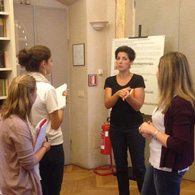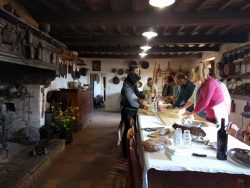 ANFS 370:Anthropology of Food students explored the notion of food as cultural heritage by visiting two sites in Città di Castello: the heritage orchard “Fondazione Archeologia Arborea”, and the Research Center and Museum of Folk Traditions or “tradizioni popolari”. Below is a reflection written by one anthropology student, Gerard Pozzi:
ANFS 370:Anthropology of Food students explored the notion of food as cultural heritage by visiting two sites in Città di Castello: the heritage orchard “Fondazione Archeologia Arborea”, and the Research Center and Museum of Folk Traditions or “tradizioni popolari”. Below is a reflection written by one anthropology student, Gerard Pozzi:
“Our class field trip to Città di Castello provided me with both an authentic and colorful glimpse into the history of rural life. The orchard has the goal to preserve heritage species of fruits (that would otherwise disappear). I found particularly interesting the emphasis on the preservation of tradition and heritage, occuring simultaneously with the incorporation of modern scientific and agricultural techniques. The curator of the orchard, Isabella Dalla Ragione, taught us the tremendous history behind each fruit, and the unique tastes and recipes that are uncovered when (excuse the pun) digging — though, rather, picking — bits and pieces from the past.
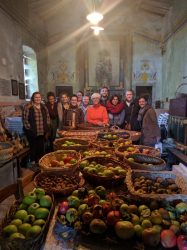 The heritage farmhouse was an enriching experience, engaging all of the senses to experience what life in this farmhouse once resembled. I was interested in the agricultural and household equipment, from old tractors to (what was then) innovative kitchen tools. My favorite room, I (unsurprisingly) have to say, is the kitchen. The immense hearth in the center resonated with me, as it put emphasis on the process of making the local version of torta al testo, ‘ciaccia.’
The heritage farmhouse was an enriching experience, engaging all of the senses to experience what life in this farmhouse once resembled. I was interested in the agricultural and household equipment, from old tractors to (what was then) innovative kitchen tools. My favorite room, I (unsurprisingly) have to say, is the kitchen. The immense hearth in the center resonated with me, as it put emphasis on the process of making the local version of torta al testo, ‘ciaccia.’
The visit and tour of Isabella’s property and the heritage farmhouse in Città di Castello was informative and inspiring. It reminded me of the importance of preserving heritage and tradition in a way that does not distance us too much from the past. In my opinion, it is important, even today, with modern technology and innovation constantly in flux, to expose younger generations to the past, antique ways of life. Perspective on both the past and the present is eternally useful”


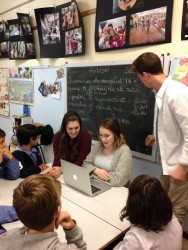 As in previous semesters, students will return to provide an interactive language and culture lesson
As in previous semesters, students will return to provide an interactive language and culture lesson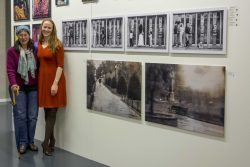
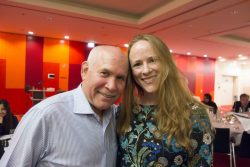
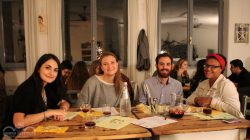 Students enjoy discussing lifestyle and cultural differences among friends
Students enjoy discussing lifestyle and cultural differences among friends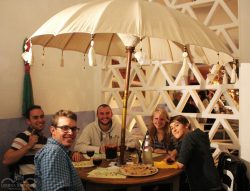
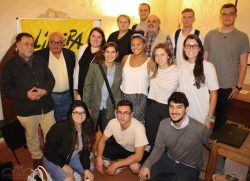 Students after a presentation about the Mafia in Umbra’s Aula Magna
Students after a presentation about the Mafia in Umbra’s Aula Magna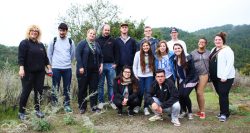
 Current Umbra staff member and Fall 2014 alumna, Ashley Webb, in collaboration with professor Antonella Valoroso and Spring 2016 alumna Shameesha Pryor, wrote
Current Umbra staff member and Fall 2014 alumna, Ashley Webb, in collaboration with professor Antonella Valoroso and Spring 2016 alumna Shameesha Pryor, wrote 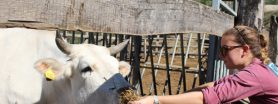
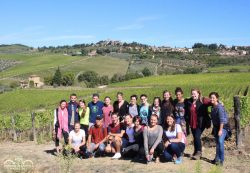 Students then hiked through the surrounding territory to learn more about the geographical region in which Dario raises his cattle (some in the Chianti area, others in Catalonia, Spain) as well as the significance of agriculture in the area. They met and even fed hay to some of the local cattle before returning to the town of Panzano for lunch at Dario’s restaurant. Students enjoyed a meal that offered selections from every part of the cow, atop a placemat that illustrated the menu’s various uses of meat cuts.
Students then hiked through the surrounding territory to learn more about the geographical region in which Dario raises his cattle (some in the Chianti area, others in Catalonia, Spain) as well as the significance of agriculture in the area. They met and even fed hay to some of the local cattle before returning to the town of Panzano for lunch at Dario’s restaurant. Students enjoyed a meal that offered selections from every part of the cow, atop a placemat that illustrated the menu’s various uses of meat cuts.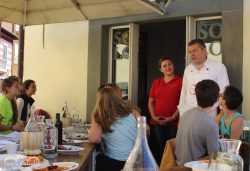
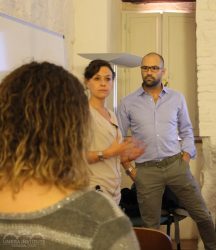 Prof. Elisa Ascione translates the words of SapereFood’s Filippo
Prof. Elisa Ascione translates the words of SapereFood’s Filippo
